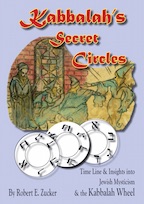The Use of Color and the Kabbalah
Since it was forbidden to visualize the ten Sephiroth, colors were substituted by the Kabbalists. Colors are the “covering” of the Sephiroth. This may have been the “world of lights” which emanated from the Sephiroth, according to the authors of TIKKUNEY ZOHAR and RA'YA MEHEIMMA. While color-based meditation became a popular part of Kabbalah during the lifetime of Isaac the Blind, color attributes to the ten Sephiroth were first proposed by one of the founders of the Chasidic movement, Spanish Kabbalist, Rabbi David ben Yehudah he-Chasid, in the late 13th early to early 14th century. In the earliest text that explicitly refers to the use color as a mystical technique, Rabbi Yehuda remarked that we are “not allowed to directly visualize the ten Sephiroth.” He suggested to imagine each sphere according to its respective color. The imaginary “colors” are the “covering” or “vessel” of the sephiroth. In the late 13th century, R. Joseph ben Shalom Ashkenazi included the visualization of colors as part of his meditative technique. The relation between colors and the Sefiroth occurred several times in his Commentary on SEPHER YETZIRAH and Commentary on GENESIS RABBAH. R. Chayim Vital mentioned the use of color visualization in his SHA'AREY KEDUSHAH and ended with the ascent to 'Aravot, where “one should visualize the firmament with a great white curtain upon which the Tetragrammaton is inscribed in [color] white as snow in Assyrian writing in a certain color.” He copied this passage from R. Joseph Ashkenazi. R. Mohe Cordovero wrote in his 16th century PARDES RIMONIM (ORCHARD OF POMEGRANATES) that “it is good and fitting if he wishes to visualize these havayot [that is, the different vocalizations of the Tetragrammaton according to their color, as then his prayer will be very effective, on the condition that his [mystical] intention is that there is no other possible way to represent the activity of a certain attribute [but] the certain [corresponding] color. And as the colors in the gate of colors are many, we shall not discuss here the colors. But when he is interested to direct his prayer behold that gate which is before [the eyes] of the disciple.” While there are some variations between the colors attributed to each Sephiroth, these are the most agreed upon:
Read more sample chapters and download a free PDF sample compliments of the author from the book, Kabbalah's Secret Circles.
Kabbalah's Secret CirclesKabbalahEntertainment Magazine© 2017-2019 Copyright by Robert Zucker. Entertainment Magazine.EMOL.org.
|
